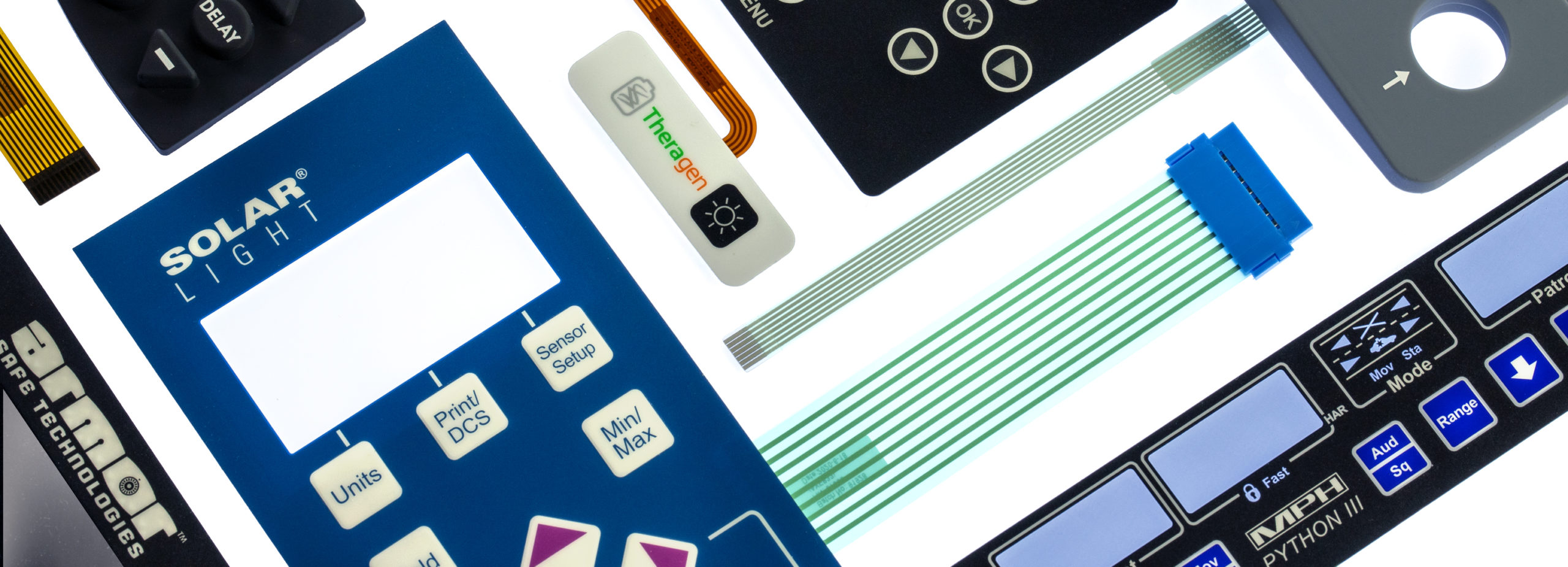Many designers favor working with a proven membrane switch manufacturer for custom builds.
Everything About Membrane Layer Change: Understanding Its Style and Capability
When you consider the control interfaces in modern-day devices, membrane buttons usually come to mind. These elements are greater than just switches; they blend design and functionality flawlessly. Comprehending how they function and what makes them efficient can alter your viewpoint on daily electronic devices. There are nuances to their layout and efficiency that you may not be aware of. Allow's explore what sets membrane switches over in addition to various other control systems.
What Are Membrane Buttons?

Their seamless nature makes them simple to tidy and immune to dirt and moisture, an important feature in many atmospheres. Membrane layer buttons can also be tailored regarding shape, size, and graphics, allowing producers to create distinct interfaces customized to certain items. Plus, they're lightweight and slim, which assists in lessening the general bulk of gadgets. In general, membrane switches play a significant role in enhancing user experience across a vast selection of applications.
How Membrane Layer Changes Job
When you push a key on a membrane switch, it turns on a straightforward yet efficient mechanism. membrane switch manufacturer. The top layer, frequently made of versatile product, presses down onto a conductive layer below it.
You'll notice that the tactile comments varies based upon the button style, offering either a soft click or a more pronounced response. Once you launch the secret, the membrane layer returns to its original setting, resuming the circuit and quiting the signal. This process happens nearly instantly, ensuring a responsive customer experience.
Membrane buttons are popular because of their sturdiness and resistance to dust and moisture, making them excellent for different applications, from family devices to medical tools. Understanding this procedure assists you appreciate their extensive use.
Key Components of Membrane Layer Buttons
Understanding the key elements of membrane layer buttons is essential for realizing their functionality and design. At the core, you'll find the graphic overlay, which offers the aesthetic user interface for users. Below that, there's a spacer layer that separates the circuit layers, guaranteeing that they don't make call till pushed. The circuit layer is where the magic occurs; it includes conductive traces that complete the circuit when you push the button. Another necessary aspect is the sticky backing, permitting the button to abide by surfaces safely. Ultimately, the protective layer guards versus environmental variables and wear, prolonging the switch's lifespan. Each element plays a substantial function in guaranteeing reliable performance and customer communication. By comprehending these components, you'll get understanding into just how membrane layer switches operate and find more their importance in numerous applications.
Products Made Use Of in Membrane Change Design
The efficiency and toughness of membrane changes greatly depend on the products used in their design. You commonly come across polyester and polycarbonate as primary substrates because of their exceptional stamina and flexibility. These materials stand up to scratches and chemicals, making them suitable for demanding settings.
The conductive layers commonly utilize silver or carbon, selected for their integrity and conductivity. membrane switch manufacturer. Silver offers superior performance, while carbon is a cost-efficient alternative. For the overlay, you may take into consideration a matte or glossy finish, depending upon your visual demands and customer experience
Make certain to pick adhesives that endure environmental factors like temperature and moisture. Selecting the ideal products will certainly assure your membrane layer button stands the examination of time.
Layout Factors To Consider for Membrane Switches
While designing membrane buttons, it's crucial to take into account different factors that affect their functionality and user experience. Begin by focusing on the format and switch dimension; make certain they're intuitive and simple to navigate.
Validate your layout suits ecological aspects, like dampness or temperature variations, which could impact performance. By very carefully thinking about these components, you'll produce a membrane button that boosts usability and fulfillment.
Applications of Membrane Buttons
Membrane switches are versatile parts located in numerous applications, from industrial equipment to customer electronic devices. You'll see their effect in makers that need resilient interfaces and in devices why not look here that take advantage of sleek styles. Recognizing these applications assists you appreciate the functionality and usefulness of membrane layer buttons in daily innovation.
Industrial Devices Use
When you're looking to boost the capability of industrial devices, membrane layer buttons provide a reputable option that combines sturdiness with user-friendly layout. These buttons are perfect for rough atmospheres, offering resistance to dust, dampness, and chemicals. Accept membrane layer buttons to improve your procedures and improve total performance.
Consumer Electronic Devices Combination
In the domain of customer electronic devices, membrane layer buttons play a crucial role in enhancing user interaction and gadget performance. Membrane layer buttons likewise guarantee resilience and resistance to dirt and wetness, extending the lifespan of your electronics. By selecting membrane switches, you enhance not just the functionality yet likewise the design of your devices, making everyday interactions smooth and satisfying.
Advantages and Disadvantages of Membrane Buttons
While membrane buttons offer a range of advantages, they additionally come with some drawbacks that you should consider. One considerable benefit is their portable layout, making them perfect for space-constrained applications.

Membrane layer buttons can have a much shorter lifespan contrasted to mechanical buttons, particularly under heavy usage. They can likewise be less tactile, which may impact individual feedback during operation. Stabilizing these pros and cons will certainly aid you establish if membrane switches are the appropriate fit for your task.
Often Asked Concerns
The Length Of Time Do Membrane Switches Typically Last?
Membrane switches normally last between 5 to 10 years, depending upon use and ecological problems. You'll want to examine variables like wear, direct exposure to wetness, and temperature fluctuations to gauge their durability efficiently.
Can Membrane Layer Switches Over Be Customized for Specific Styles?
Yes, you can customize membrane layer switches to fit certain layouts (membrane switch manufacturer). You'll have the freedom to select colors, forms, and formats that match your job's demands, ensuring they mix effortlessly with your general aesthetic
What Is the Expense Range for Membrane Switch Over Manufacturing?
The cost variety for membrane layer button manufacturing typically drops between $1 and $10 per system, relying on factors like style intricacy, quantity, and products. You can obtain quotes from manufacturers to find the very best option.

Are Membrane Switches Water Resistant or Resistant?
Membrane layer buttons can be made to be water-proof or resistant, depending upon materials made use of and construction methods. If you need them for wet environments, assure you specify those requirements throughout the layout process.
Exactly How Do Membrane Layer Switches Compare to Standard Buttons?
Membrane buttons are typically thinner and extra you can find out more versatile than typical buttons, using a streamlined layout. They're usually simpler to clean and integrate, however may not provide the responsive responses you're used to with mechanical choices.
Final thought
